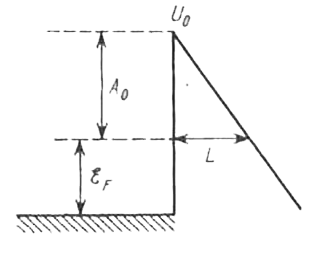Estimate the probability of cold electron emission from a metal, if there is a uniform field of strength E close to the surface of the metal.
Text Solution
The correct Answer is:a=√8mA30/eEh;w=e−a
In the absence of an external electric field the electron in a metal is shielded by an infinitely wide potential barrier of height U0. In the presence of a strong electric field of intensity E the potential barrier assumes a triangular shape with height U0 and width L=Φ/E=A0/eE, where A0 is the work function. Neglect the shape of the barrier and assume it to be rectangular. Since the energy of the electrons in the metal is εF, and their work function is A0=U0−εF, the parameter a which determines the probability of the electron tunnelling through the potential barrier assumes the form
a=2Lh√2m(U0−εF)=2A0eEh√2mA0

|
Similar Questions
Knowledge Check
Electron emission from a metallic surface by application of light is known as
AThermionic emissionBPhotoelectric emissionCHigh field emissionDAutoelectronic emissionThe process of emission of electrons from metal by UV rays is
APhotoelectrice emissionBThermionic emissionCSecondary emissionDField emissionThe photo electrons emitted from the surface of sodium metal are
AOf speeds from 0 to a certain maximumBOf same de Broglie wavelengthCOf same kinetic energyDOf same frequency
The threshold wavelength for ejection of electrons from a metal is 430 nm. The work function for the photoelectric emission from the metal is
View SolutionThe threshold wavelength for ejection of electrons from a metal is 250 nm. The work function for the photoelectric emission from the metal is
View SolutionThe threshold wavelength for ejection of electrons from a metal is 300 nm. The work function for the photoelectric emission from the metal is
View SolutionThe threshold wavelength for ejection of electrons from a metal is 230 nm. The work function for the photoelectric emission from the metal is
View SolutionAn electron of mass m and charge q is accelerated from rest in a uniform electric field of strength E. The velocity acquired by it as it travels a distance l is
View Solution
